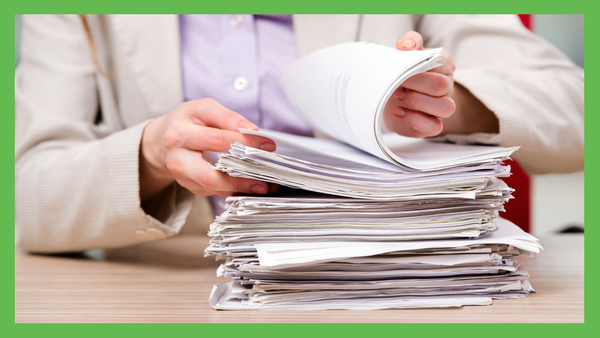If you’re getting ready to downsize – whether for a move or just to declutter – and you’ve lived in the same home for many years, one of your biggest headaches will be deciding what to do with all the paper that you’ve accumulated over the years.
Most people keep paper records far longer than necessary (the old “I might need it someday” story) simply because they’re afraid of getting rid of it. However, research shows that 85 percent of the stuff people file away is never looked at again! This is something I can attest to personally, as I have often helped clients go through file cabinets full of papers that they’ve never referred to even once since they were filed.
While it’s easy to let papers pile up over the years, figuring out what to keep and what to let go of can be overwhelming. Here are my tips for getting on top of the paper piles, so you won’t have to schlep them with you to your new home.
- Go through your files and shred old bills that are associated with your current home, such as utilities or landscaping. You can keep the current year’s statements if you don’t have online access to your bills through the company’s website.
- Do the same for credit card statements (unless you need to keep them for tax records).
- If you don’t have online access to your bank and financial statements, you can shred any that are more than 2 years old. If you really want to keep long-term records in paper form, just keep the year-end statements for each account.
- Make sure to keep records of any improvements you’ve made to your home since you bought it. Read here to see the difference between repairs and improvements, along with the latest tax laws on this topic.
- It’s generally agreed that you only need to keep 3 to 7 years’ worth of backup documents for tax purposes. Here’s a great article that tells you specifically how long to keep your tax backup. Note that none of it has to be in paper form, as the IRS accepts receipts and other documents in digital format.
- If you have access to a document scanner (such as the Fujitsu ScanSnap), I suggest scanning any documents you might need to access in the future, and keeping them in a digital filing system on your computer (backed up!) or in the cloud. (I have helped clients create digital filing systems, including showing them how to scan paper documents and how to retrieve the digital versions.)
- Go paperless by signing up for online access for as many accounts as you can. Getting your bills and statements online not only will leave you with less paper to pack and move, but also will reduce the amount of mail that needs to be forwarded to your new address.
These are some of the fairly straightforward methods I use with clients to help them get their papers ready for a move.


